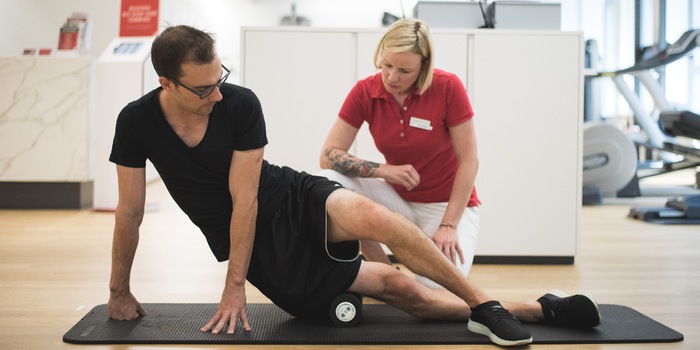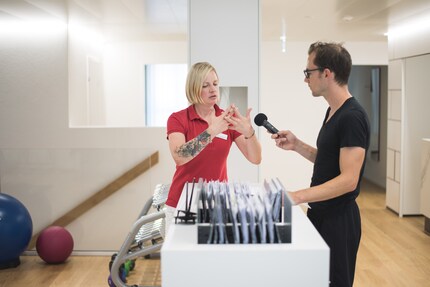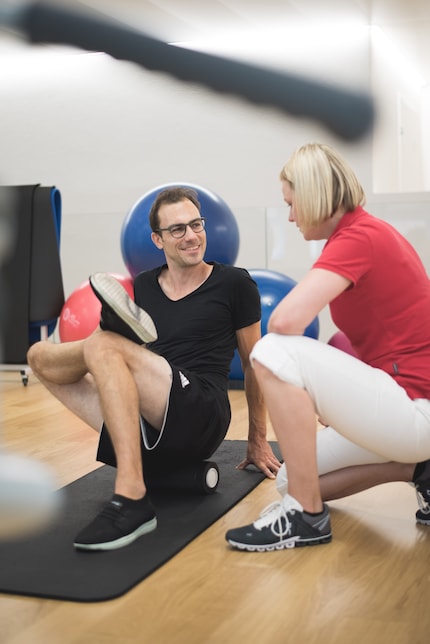

Roller goals: the benefits of fascia training
Since everyone from uptight office clerks to professional sports players started using rollers for fascia release, the long ignored fascia has become a key part of training. It got me thinking: what’s with the fad? How does fascia release work? What does it do? And most importantly… what the hell is fascia?
When I mentioned in the office I was writing about fascia training, I was met with blank looks. Sure, they all know Blackroll & Co products. Who doesn’t these days? People are fascia releasing like there was no tomorrow – in their free time, professionally and as part of physio.
Even I’m going to get rolling through our range in the next few weeks while I test out some products. But before I do, I want to clear up any confusion and find out what fascia training is all about. That’s why I met up with physiotherapist and blackroll trainer Melissa Stickel from the Zurich Physiozentrum to ask her some questions.
Melissa, what is fascia?
«Fascia is like internal skin. It’s a special type of connective tissue that encloses muscles, tendons, bones and organs. Without fascia we wouldn’t be able to stand up properly. The nervous system is the only other element in the body that is connected from head to foot. The worse the fascia is, the more difficulty we have moving.»
Is fascia just a passive shell ?
«No, fascia is active and has a purpose. It feeds information to the muscles and central nervous system about the body’s position and state. The fascia also influences muscle tension. Not only that, it can transport lymph and other liquids; activate the metabolism and stimulate the circulation.»

The fuss about connective tissue
There’s a reason for fascia, otherwise it wouldn’t be there. But does the same apply to all the products that are supposed to help it? After all, connective tissue isn’t some new thing that’s just appeared in the body. Dynamic stretching exercises and massage have been part of the repertoire in sports and therapy for a long time.
I didn’t see a single fascia roller in the four years I studied sports. That type of connective tissue wasn’t even a big topic back then as far as training went. A few years later and you can’t go anywhere without seeing these simple little devices. Here are all the different things they can be used for:
- increasing range of movement
- stabilising muscular imbalance (this is when flexors and extensor muscles aren’t balanced or there’s an imbalance between the muscles on the left and right side of the body)
- warming up before training or competitions
- actively recovering after stress/weight bearing exercise
- combining with strength and coordination exercises.
As a general rule, I’m a bit sceptical when something like fascia training gets a lot of hype. But I did try it out eventually and I stuck with it. I like to use the roller for a few exercises in the evening and subjectively speaking, I think it helps. Relaxation feels so good for the body.
But looking at the bigger picture, there hasn’t been much research yet that could justify the extent of the success. What we do know is that fascia release has a positive effect on movement and recovery, although we’re still waiting on reliable studies. I’m interested in finding out from Melissa why this training has got so popular all of a sudden.
Have there been new scientific discoveries or is it just good marketing?
«It was only about ten years ago that we discovered how important fascia is for body function. That’s when the hype around the rollers began and words like fascia training and fascia fitness started popping up. One thing is for sure, the roller is good for supporting and adding to training but of course it doesn’t replace other exercise. At the end of the day, it’s nothing more than a slightly softer rolling pin.»
What happens to the body when you use a roller?
«Compression puts pressure on the tissue, thereby creating a kind of sponge effect. The cells get squeezed out so they fill up with oxygen and nutritious liquid again. The fibres gets aligned and supplied with everything it needs. Recovery time is faster after sports and when you have aching muscles. If you practice with the roller regularly, muscles layers, muscle fibres and bundles of muscles can also slide towards each other more smoothly – in turn, range of movement improves.»
People often talk about adhesion and that this has to get unstuck.
«Adhesion is maybe the wrong word. It’s more like it resembles felt and the structure gets messy. It’s best to think of it like a chaotic pile of spaghetti. For example, if you sit hunched over your desk for a long time, the shoulder and chest muscles shorten. That’s when the fascia in this area locks together. The tissue gets firmer and thicker and trigger points appear.»

«Trigger points» is still a buzz phrase that’s thrown around. It refers to points where you’re particularly sensitive to pressure. Where do they tend to appear?
«These points are usually on muscle tendon insertions or on the muscle belly. The main advantage is that when use the roller for training you can choose how much pressure to exert and feel the trigger points yourself. If the pain is acute, I’d only recommend using it with expert guidance.»
Are there any situations where you shouldn’t do fascia training?
«The main time you want to avoid fascia release is if you have severe inflammation that’s characterised by redness, swelling and pain. There’s some dispute around the other contraindications, which include osteoporosis, varicose veins and being pregnant. If you fall into any of those categories, you’re generally advised not to try this roller exercise. But if you do decide to give it a go anyway, you’re best to use a softer roller, which exerts less pressure.»
Do you need to do anything before getting started with fascia release for the first time?
«You need to give yourself lots of support and bring a certain amount of tension to the body. As we’re training the muscle chains across several joints, you always get full body training. Applying zero body tension and flopping over the roller is kind of counterproductive. You’ll just be making it unbearably painful when it should actually feel like good pain.»

How often should you use the roller to get the results you want?
«Two to three times a week for up to 20 minutes. Here are the guidelines: don’t do fascia release exercises on joints and don’t roll across one point for too long as it can stop the blood supply. Stick to a maximum of two minutes per key spot. If it’s tough on your body to begin with, leave a break of two days between training sessions. But do remember that you’ll only see a difference if you practice regularly.»
How should you vary the exercises?
«Just rolling up and down won’t be effective. Instead, the fascia needs to be moved slowly and three dimensionally. You also need to roll to the right and left and maybe also tense a muscle.»
What kind of roller should you choose? They vary in firmness and texture.
«It depends on your pain tolerance. Some people are quite sensitive and react straight away. Sports people with thick muscle fibre often need more pressure. But I’d recommend beginners start with a standard roller or a softer model.»

See all the fascia training rollers in our range
The initial verdict on fascia training
Like many others before me, I’ve discovered that the first workouts can be quite painful. But your body gradually gets used to it and learns to make the pressure more targeted. While fascia training isn’t a miracle cure that can replace all other exercise, it is a useful accompaniment.
So it’s no wonder manufacturers are always bringing out new products for this booming market. Just one example of what you can get your hands on these days is the rollers with a vibrating core. It makes me wonder what advantages these rollers have over others and who they’re made for. Stay tuned to find out more in the coming weeks!
Did you like this article? You can follow me on my author profile here.
Simple writer and dad of two who likes to be on the move, wading through everyday family life. Juggling several balls, I'll occasionally drop one. It could be a ball, or a remark. Or both.
Interesting facts about products, behind-the-scenes looks at manufacturers and deep-dives on interesting people.
Show all